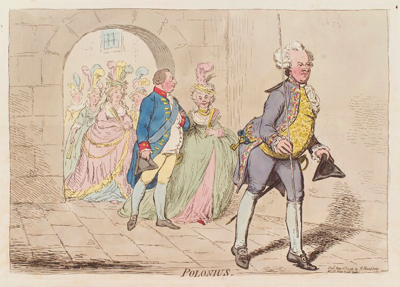Polonius
This print shows a stiff and awkward-looking Earl Salisbury in his role of Lord Chamberlain escorting the King and Queen, and four of the Princesses through an archway at (perhaps) Frogmore Lodge. The occasion may be the birthday celebration for the new Princess of Wales which was described in the Morning Chronicle on May 18th.
This evening there is to be a grand ball and supper given by the queen at Frogmore Lodge, to which all the branches of the Royal Family, Prince and Princess of Orange, and Family, a select party of the Nobility of both sexes, in compliment to the Princess of Wales.
The arrangement of ceremonial occasions such as this would have been part of Salisbury's role.

© National Portrait Gallery, London
The title of the print, Polonius comes from, of course, the officious and humorless minister in Shakespeare's Hamlet, whose interference in his daughter's relationship with Prince Hamlet has such disastrous consequences. Indeed, the Earl appears sufficiently awkward and rigid to qualify as a Polonius-like figure. But why then the additional participants in the print? If this were simply a portrait caricature, we only need Salisbury himself.
One clue may be the fact that through the arch behind the king, there are only women visible. If this were a typical royal procession, the princes, in order of rank, would surely appear. Instead we seem to have only princeses. And all are poised on the other side of the threshold formed by the arch. And though the Lord Chamberlain is the larger and more prominent figure, it is George III who is closer to the center of the print and whose body continues the line of that arch.
As Janice Hadlow has well documented in her book, A Royal Experiment, the attempt by the King (and Queen) to control their children's marriages was disastrous for all of them, but perhaps most sad and difficult for their six daughters whose lives remained in suspension while potential suitors were measured and rejected time and time again. Three of the six never crossed the threshold to marriage; two of the remaining three married very late in life. Only the Princess Royal married in what could be called due course.
Gillray's prints often move in several directions simultaneously, and, as a result, their meaning is sometimes ambiguous. So it would not be exceptional to think that the title of the print, Polonius, may have an ambiguous and divided reference to both the Lord Chamberlain and (perhaps) to King George.
Sources and Reading
- Commentary from the British Museum on Polonius
- "James Cecil, 1st Marquess of Salisbury," Wikiwand
- "Lord Chamberlain," Wikipedia
- Janice Hadlow, A Royal Experiment, 2014.
- Thomas Wright and R.H. Evans, Historical and Descriptive Account of the Caricatures of James Gillray #123
Comments & Corrections
NOTE: Comments and/or corrections are always appreciated. To make that easier, I have included a form below that you can use. I promise never to share any of the info provided without your express permission.